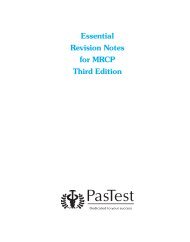OSCEs for Medical Students, Volume 3 Second Edition
OSCEs for Medical Students, Volume 3 Second Edition
OSCEs for Medical Students, Volume 3 Second Edition
Create successful ePaper yourself
Turn your PDF publications into a flip-book with our unique Google optimized e-Paper software.
122 <strong>OSCEs</strong> <strong>for</strong> <strong>Medical</strong> <strong>Students</strong>, <strong>Volume</strong> 3AnswersCommentThe key to all paediatric examination is good observation. From a distance look <strong>for</strong>tachypnoea, distress and hyperexpansion (seen best from the side) or asymmetricalexpansion. Auscultation is usually best in babies if they are quiet, but in olderchildren expansion, percussion should take place first. Always explain to the child andexaminer what you are doing. Never <strong>for</strong>get the peak flow and weight. Also, if you aredoing something, be prepared to say why (there is little point percussing or elicitingvocal fremitus in a child with equal and normal breath sounds).Common conditions in <strong>OSCEs</strong> are CF, asthma, chronic lung disease (ex-prem) orpossibly a baby recovering from bronchiolitis. In CF there will probably be a mixtureof inspiratory crackles and expiratory wheeze (many have asthma too) and may beunderweight. Those with chronic lung disease often have some degree of chestde<strong>for</strong>mity and scars on their hands from repeated cannulation.
















